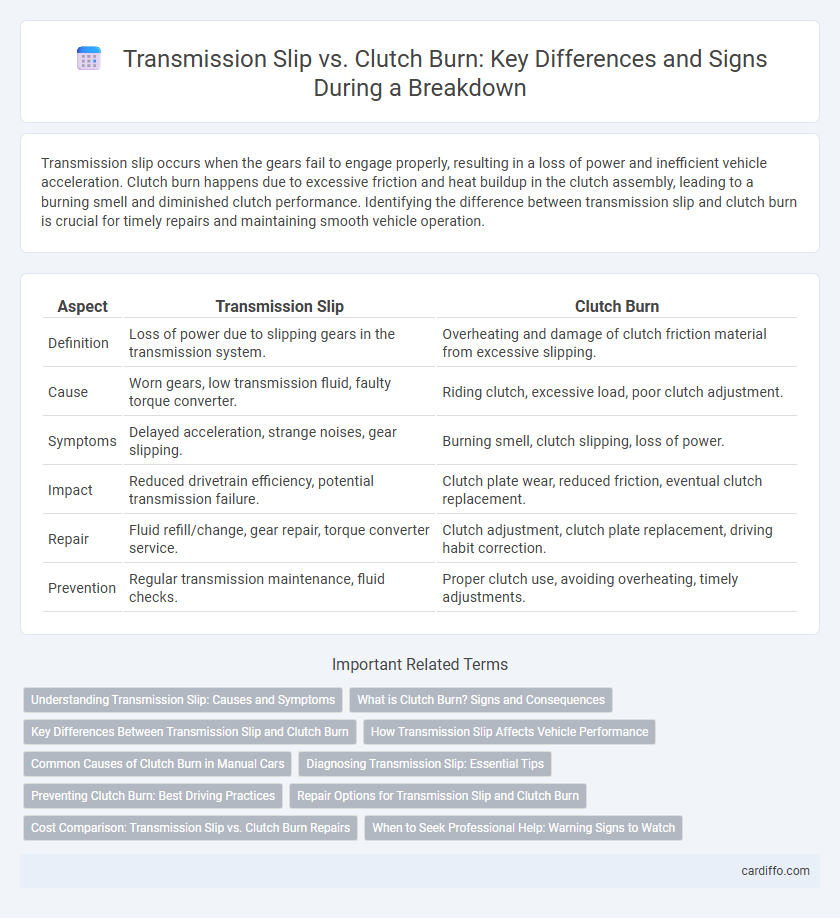Transmission slip occurs when the gears fail to engage properly, resulting in a loss of power and inefficient vehicle acceleration. Clutch burn happens due to excessive friction and heat buildup in the clutch assembly, leading to a burning smell and diminished clutch performance. Identifying the difference between transmission slip and clutch burn is crucial for timely repairs and maintaining smooth vehicle operation.
Table of Comparison
| Aspect | Transmission Slip | Clutch Burn |
|---|---|---|
| Definition | Loss of power due to slipping gears in the transmission system. | Overheating and damage of clutch friction material from excessive slipping. |
| Cause | Worn gears, low transmission fluid, faulty torque converter. | Riding clutch, excessive load, poor clutch adjustment. |
| Symptoms | Delayed acceleration, strange noises, gear slipping. | Burning smell, clutch slipping, loss of power. |
| Impact | Reduced drivetrain efficiency, potential transmission failure. | Clutch plate wear, reduced friction, eventual clutch replacement. |
| Repair | Fluid refill/change, gear repair, torque converter service. | Clutch adjustment, clutch plate replacement, driving habit correction. |
| Prevention | Regular transmission maintenance, fluid checks. | Proper clutch use, avoiding overheating, timely adjustments. |
Understanding Transmission Slip: Causes and Symptoms
Transmission slip occurs when the transmission fails to engage properly, causing the engine to rev without corresponding acceleration. Common causes include worn-out clutch plates, low transmission fluid, or damaged gears, leading to reduced power transfer and vehicle performance. Symptoms often involve delayed gear shifts, slipping sensations during acceleration, and unusual noises indicating internal transmission issues.
What is Clutch Burn? Signs and Consequences
Clutch burn occurs when excessive heat damages the clutch lining, causing slipping and reduced power transfer between the engine and transmission. Signs of clutch burn include a burning smell, difficulty shifting gears, and a noticeable drop in vehicle acceleration. Consequences of clutch burn can lead to costly repairs, decreased fuel efficiency, and potential transmission damage if not addressed promptly.
Key Differences Between Transmission Slip and Clutch Burn
Transmission slip occurs when the transmission's internal components fail to engage properly, causing delayed or inconsistent power delivery to the wheels, while clutch burn arises from excessive friction between the clutch disc and flywheel, leading to overheating and material degradation. Transmission slip is often marked by erratic shifting and slipping gears, whereas clutch burn results in a distinct burning smell, reduced clutch responsiveness, and visible wear on the clutch plate. Understanding these key differences is crucial for accurate diagnosis, as transmission slip requires repairs within the gearbox, whereas clutch burn demands clutch replacement or adjustment.
How Transmission Slip Affects Vehicle Performance
Transmission slip directly impairs vehicle performance by causing delayed or erratic gear shifts, reducing acceleration efficiency and fuel economy. This slippage generates excess heat, accelerating wear on transmission components and increasing the risk of costly mechanical failures. Unlike clutch burn, which affects power transfer primarily during gear changes, transmission slip compromises overall drivability and engine responsiveness across all driving conditions.
Common Causes of Clutch Burn in Manual Cars
Clutch burn in manual cars commonly occurs due to excessive riding of the clutch pedal, which causes overheating and accelerates wear on the clutch plates. Frequent stop-and-go traffic or improper gear shifting techniques, such as slipping the clutch during acceleration, increase friction and lead to premature clutch failure. Poor clutch adjustment and using the clutch to hold the car on inclines also contribute significantly to clutch burn, requiring timely maintenance to avoid costly repairs.
Diagnosing Transmission Slip: Essential Tips
Diagnosing transmission slip involves monitoring engine RPM and vehicle speed for discrepancies that indicate power loss. Check transmission fluid levels and condition, as low or degraded fluid often causes slippage in automatic transmissions. Inspect clutch components for wear or damage in manual transmissions, since clutch burn can mimic transmission slip symptoms but requires distinct repair approaches.
Preventing Clutch Burn: Best Driving Practices
Preventing clutch burn requires minimizing excessive slipping by fully engaging the clutch during gear shifts and avoiding riding the pedal. Maintaining proper engine RPMs and shifting smoothly reduces heat buildup and wear on clutch components. Regular inspection and adjustment of the clutch system ensure optimal performance and extend its lifespan.
Repair Options for Transmission Slip and Clutch Burn
Repair options for transmission slip include fluid replacement, clutch plate adjustment, or complete transmission rebuild depending on wear severity. Clutch burn often requires clutch disc replacement, resurfacing of the flywheel, and inspection of the pressure plate to restore proper engagement. Early diagnosis and repair prevent further drivetrain damage and ensure optimal vehicle performance.
Cost Comparison: Transmission Slip vs. Clutch Burn Repairs
Transmission slip repairs typically cost between $1,000 and $3,000 due to complex internal component replacements, while clutch burn repairs generally range from $500 to $1,500, reflecting the labor-intensive but less expensive nature of clutch plate replacement. Transmission issues often require specialist tools and extended service time, increasing overall expenses compared to clutch repairs, which primarily involve replacing worn friction material. Choosing timely clutch maintenance can prevent costly transmission damage, significantly impacting long-term vehicle repair budgets.
When to Seek Professional Help: Warning Signs to Watch
Transmission slip and clutch burn both signal critical drivetrain issues requiring immediate attention. Persistent slipping, unusual noises, burning smells, or delayed gear engagement often indicate severe damage needing professional diagnosis. Prompt service prevents further transmission failure and costly repairs, ensuring vehicle reliability and safety.
Transmission slip vs clutch burn Infographic

 cardiffo.com
cardiffo.com